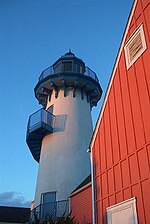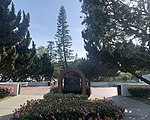Fisherman's Village is a waterfront mall, commercial boat anchorage and tourist attraction located in the world's largest man-made small boat harbor in Los Angeles County at Marina del Rey, California. The Ballona Wetlands State Ecological Reserve is just east of Fisherman's Village and immediately to the south is the federally-owned riverine estuary of Ballona Creek. The historical Fisherman's Village, built in 1967, is nestled on the eastern bank of main harbor entrance channel between Whiskey Reds restaurant to the south and the Windward boatyard to the north.
Fisherman's Village was developed and built by the Sheldon L. Pollack Corporation. The company also developed and/or built several other similar projects in Southern California including San Diego Seaport Village, Port Hueneme Fisherman's Village (now called Fisherman's Wharf Channel Islands Harbor) and Oceanside Harbor Village.
Constructed in the style of a New England fishing village, Fisherman's Village consists of five brightly painted wooden buildings, a waterfront promenade, a lighthouse, a water fountain and commercial boat docks. Tourist attractions include live music concerts, restaurant and café dining, harbor and fishing cruises, boat and bicycle rentals, a Catalina Island ferry service, souvenir shops, a nightclub and a public water shuttle (harbor ferry) service.
The waterfront promenade offers panoramic views of the harbor, where approximately 5,300 pleasure boats, yachts, and commercial vessels are berthed across 21 individual marinas, including yacht clubs.
Various types of ocean-going vessels can be seen as they pass Fisherman's Village en route to, or returning from, voyages into Santa Monica Bay, Catalina Island, the Pacific Ocean and beyond. On Wednesday evenings during March to September from 5 pm to 7 pm, up to 100 sailboats from 22 to 70 feet in length can be seen, sails unfurled, racing toward the finishing line in California Yacht Club's (CYC) Sunset Series regatta.
The address of Fisherman's Village is 13755 Fiji Way, Marina del Rey, California, 90292-6909. It is situated on Los Angeles County land (public land) and designated as parcel #56 by the DBH (Department of Beaches and Harbors). DBH lease the parcels on the public's behalf. The adjoining public parking lot #1 is managed by Parking Concepts International (PCI) on behalf of DBH.
The lessee of Fisherman's Village is 'Gold Coast Village, LLC' who have appointed their property management company, 'Pacific Ocean Management'. The leasee also holds other parcels in Marina Del Rey such as Admiralty Apartments on Admiralty Way, Marina Beach strip mall on Washington Boulevard and Pier 44/Dock 77 marinas. Shoreline Village in Long Beach is another lease held.
Other entities of note adjoining Fisherman's Village are: US Coast Guard station, MDR LA Sheriff's Department station, the LA County Department of Beaches and Harbors (DBH) executive offices, Whiskey Red's restaurant, Villa Venetia apartment complex, UCLA rowing sheds to the south and Loyola Marymount University (LMU) rowing sheds, The Boatyard and DBH trailer offices to the North-east.
Since the late 1970s, Fisherman's Village has faced a decline of stores closing due to the leasing issues. A seal cage was emptied and various arcades for pinball machines and video games closed, including an eponymous arcade owned by actor Gary Coleman in the early 1990s. At times, the boat tours were shut down as well.
There has been an effort to rebuild Fisherman's Village with a parking complex, however, due to the millions of dollars involved in order to add new shops and stores, as well as the influx of heavy traffic, it had to go through several environmental impact reports before any demolition could take place. No decision has been made at this time.
The parking lot had to start charging fees in order to pay for the maintenance of Fisherman's Village.








